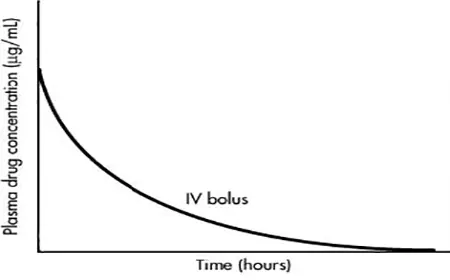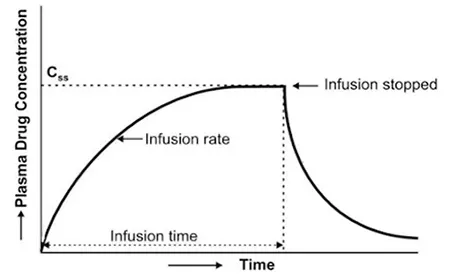IV bolus injection or IV bolus vs IV infusion is both the dosage form or method or ways of administering medicine via parenteral routes. The word ”parenteral” originates from the roots ‘para’ means beyond, outside of and ‘enteral’ means intestinal. The parenteral administration introduces drugs directly into the systemic circulation or other vascular tissue across the body’s barrier defenses.
Parenteral routes are used for emergencies, for uncooperative or unconscious or vomiting patients, for rapid onset of action, for drugs that are poorly absorbed from the GIT (for example heparin), and for drugs that are unstable in the GIT (for example, insulin). Examples of parenteral routes of administration include intravenous, subcutaneous, intra-arterial, and intramuscular etc. Intravenous (IV) drug products may be given either as a bolus dose or slowly infused [1]. You may also read: Side effect and Toxic effect, Poison and Toxin
Table of Contents
Definition of IV Bolus vs IV Infusion
IV is the short form of Intravenous means “within a vein.” It is a parenteral route of drug administration. The word “bolus” comes from the Latin bolus means ball. In biopharmaceutics or medicine, a bolus refers to the administration of a discrete amount of medication, drug, or other agents within a short time generally 1–30 minutes [2]. A bolus is a single, large, discrete dose of a drug product. IV bolus and IV bolus injection indicate the same meaning. An injection is a small volume of sterile preparation intended for the parenteral administration of a drug or liquid by using a hypodermic needle and a syringe. An injection is also known as “jab” (UK English), “shot” (US English), and “jag” (Scottish English) [3].
When a sterile, single, discrete amount dose of drug product, medication, or solution is administered all at once over a short period of time generally within a short time 1–30 minutes by using a hypodermic needle and a syringe is called IV bolus.
When a sterile, large volume of drug product, medication, or solution is administered through a vein into the blood slowly and continuously at a constant or zero-order rate over a long period of time generally more than 30 minutes to several hours is called IV infusion. Intravenous infusion also known as an IV drip, IV inf.
Total Time of Administration
IV bolus is given within a short period of time generally within 1–30 minutes [4]. Whereas IV infusion is given within a long period of time generally more than 30 minutes to several hours.
Rate of Administration of IV Bolus vs IV Infusion
IV bolus is given at an inconstant rate and expressed by mg/min. Whereas IV infusion is given at a constant rate and expressed by mg/hr. Aminophylline is administered by IV infusions at a rate of 34 mg/hr. So, the total daily dose of aminophylline is 34 mg/hr x 24 hr = 816 mg. The IV infusion rate may be estimated after assessment of the patient’s clearance, ClT.
Fashion of Administration of IV Bolus and IV Infusion
IV bolus drug administration is rapid. Whereas in the case of IV infusion, drug administration is slow and given either intermittently or continuously.
Onset of action of IV Bolus vs IV Infusion
In general, IV bolus administration of a drug provides the most rapid onset of drug action. Thus providing a fast-acting therapeutic effect. Whereas IV infusion administration of a drug provides the slow onset of drug action. Thus providing a delayed therapeutic effect.
Duration of action
Duration of action of IV bolus administration of a drug is short. On the other hand, the duration of action of IV infusion administration of a drug is long.
Purpose of Use of IV Bolus vs IV Infusion
- Drug is given as an IV bolus for an emergency such as cardiac arrest or narcotic overdose to get an immediate effect.
- IV bolus is given as a loading dose to achieve the desired plasma level rapidly.
On the other hand, the Purposes of Use of IV infusion are:
- IV infusion is necessary when continuous and prolonged plasma drug concentration is required.
- An IV infusion is given as a maintenance dose to maintain the steady-state by abolishing wide fluctuations of plasma drug concentration.
- IV infusion allows control of plasma drug levels more precisely.
- The duration of drug therapy may control or dismiss as needed using IV infusion.
- IV infusion may give to estimate of total body clearance if the steady-state level and infusion rate are known.
- Slow IV infusions of a drug product may administer to avoid side effects.
Volume of IV Bolus vs IV Infusion
Volume of IV bolus drug product, medication, and liquid is smaller than the IV infusion. Whereas the Volume of the IV bolus drug products, medication, and liquid is larger than the IV bolus.
Control of Drug delivery by IV Bolus and IV Infusion
Drug delivery is not controlled in the case of IV bolus because they are injected all at once. On the other hand, IV infusion allows precise control of plasma drug concentrations to fit the individual needs of the patient by infusion rate.
Adverse effect of medication of IV Bolus vs IV Infusion
The chance of anaphylaxis or adverse effect is more in the case of IV bolus. The rapid IV bolus injection of many drugs (for example lidocaine) may cause an adverse response due to the initial high drug concentration in the plasma before slow equilibration with the tissues.
On the other hand, the Chance of anaphylaxis or adverse effect is less in the case of IV infusion. The IV infusion of many drugs (for example lidocaine) may cause less adverse response due to slow and continuous infusion.
Discomfort during application of IV Bolus vs IV Infusion
There is minimal or no long-time discomfort for the patient due to short-time drug product administration. Whereas the patient feels discomfort due to long-time administration.
Precaution of IV Bolus vs IV Infusion
Inject IV bolus medications after confirmation with more precaution and proper knowledge about the drug product, its dose, and drug-drug interaction because once injected you can’t control. On the other hand, IV infusions should administer with less precaution but with proper knowledge about the drug product, its dose, and drug-drug interaction because you can stop infusion at any time. Tissue damage may frequently occur at the site of infusion.
Operation of IV Bolus vs IV Infusion
Administration of IV bolus is easier and requires only the skill of insertion of a hypodermic needle. Administration of IV infusion is less easy than bolus and requires skill in insertion and ascending of infusion equipment.
Plasma level time Curve of IV Bolus vs IV Infusion
After an IV bolus injection, the drug is rapidly perfused to tissue and then drug concentration declines with time from the body.

Figure: Plasma level time curve for IV Bolus
On the other hand, after an IV infusion, the drug is slowly infused into plasma and gradually increases plasma drug concentration with time and attains steady-state, plateau, and after discontinuation of infusion drug concentration decline with time from the body. Efficacy vs Potency

Figure: Plasma level time curve for IV infusion
Types of IV Bolus vs IV Infusion
According to the Fashion of Administration, IV infusions are two types:
- Intermittent IV infusion: It is a method of successive infusions of the drug for a short period of time after the drug elimination period of the previous IV infusions.
- Continuous IV infusion: An intravenous infusion is the infusion of a parenteral drug product over several hours (continuous drip) to days continuously.
Based on the rate of administration, IV infusions are two types:
- High rate of infusion
- Low rate of infusion
According to the frequency of administration, IV bolus is two types:
- Single IV bolus: injected the drug rapidly at once.
- Multiple IV bolus: injected repeatedly at regular intervals to achieve a steady plasma concentration.
Equipment for IV Bolus vs IV Infusion
Equipment of IV bolus: Hypodermic needle and syringe.
Whereas Equipment of Intravenous Infusion: IV bag, peripheral cannula, Tourniquet, Drip set (Insertion spike, drip chamber, Screw clamp, Extension Tube with secondary port, hollow needle, Y-Set or T-Set or V connector sets) as well as infusion pump for digital infusion equipment.
Examples of IV Bolus vs IV Infusion
Examples of IV bolus: Edrophonium IV bolus injection and Morphine IV bolus injections etc. On the other hand, Examples of IV infusion: Dextrose solutions, Succinylcholine infusion. Epinephrine IV infusion, Dopamine IV infusion, and Nicardipine intravenous infusion etc.
Summary of IV Bolus vs IV Infusion
| Features | IV Bolus | IV Infusion |
| Definition | When a sterile, single, discrete amount dose of drug product, medication, or solution is administered all at once over a short period of time generally within a short time 1–30 minutes by using a hypodermic needle and a syringe is called an IV bolus. | When a sterile, large volume of drug product, medication, or solution is administered through a vein into the blood slowly and continuously at a constant or zero-order rate over a long period of time generally more than 30 minutes to several hours is called IV infusion. |
| Administration Time | Within 1–30 minutes | More than 30 minutes to several hours |
| Administration Rate | Inconstant rate and express by mg/min | Constant rate and express by mg/hr |
| Fashion of Administration | Rapid | Slow and Continuous |
| Onset of action | Rapid | Slow |
| Duration of action | Short | Prolonged |
| Purpose of Use | For an emergency and to achieve the desired plasma level rapidly. | For continuous and prolonged plasma drug concentration and control of plasma drug levels more precisely |
| Volume | Small | Large |
| Control of Drug delivery | No precise control. | Precise control. |
| Adverse effect | The chance of anaphylaxis or adverse effect is more. | The chance of anaphylaxis or adverse effect is less. |
| Discomfort | Less | More |
| Precaution | More precaution. | Less precaution. |
| Operation | Easier | Less easy than IV bolus |
| Types of IV Bolus vs IV Infusion | According to the Fashion of Administration, IV infusions are two types: A. Intermittent IV infusion and B. Continuous IV infusion. Based on the rate of administration, IV infusions are two types: A. High rate of infusion and B. Low rate of infusion | According to the frequency of administration, IV bolus is two types: A. Single IV bolus and B. Multiple IV bolus |
| Equipment | Hypodermic needle and syringe. | IV bag, peripheral cannula, Tourniquet, Drip set (Insertion spike, drip chamber, Screw clamp, Extension Tube with secondary port, hollow needle, Y-Set or T-Set or V connector sets) |
| Plasma level time Curve of IV Bolus vs IV Infusion |  |  |
| Examples | Edrophonium IV bolus injection and Morphine IV bolus injections | Epinephrine IV infusion, Dopamine IV infusion |
References
- Shargel, Leon, and Andrew B. C. Yu. Applied Biopharmaceutics & Pharmacokinetics, 2016.
- “intravenous bolus”. Farlex dictionary, in turn, citing Mosby’s Medical Dictionary, 9th edition.
- “injection”. Cambridge dictionary.
- Bolger, Gordon T. Reference Module in Biomedical Sciences. Routes of Drug Administration, 2018.
Keywords: IV bolus vs IV infusion; bolus vs infusion; bolus injection vs IV infusion; IV infusion vs IV bolus, Difference between injection and infusion, Difference between IV bolus and IV infusion.
Question: Which one is better between IV bolus and IV Infusion?
Answer: Both ways are better, the choice of way is depended on the purpose of the use of medication.